Part 1: 4000 BC - 2750 BC (Setup & First Contact)
In the Beginning:The first thing is to choose the game mode. Note that there’s no campaign mode or anything, every game of Civ 2 is entirely self-contained.
"Start a New Game", "Multiplayer Game", "Load a Game", and "View Credits" are presumably self-explanatory.
"Start On Premade World" allows you to play on a world that either you designed yourself or one of a few that come with the game rather than a randomly generated one. A lot of the fun of Civ 2 is exploring the world and needing to adapt your strategy to what you find (It’s one of the Xs in 4X in fact), so I don’t particularly see the appeal of that mode unless you just like having unfair advantages over the AI or playing on a word that looks like Earth so you can nuke those darned Canadians.
"Customize World" is essentially the same thing as the general Start New Game mode except that you can choose some settings that influence the geography of the randomly generated world. For example, you can change the % of the surface of the world which is land. More ocean generally means more isolation and safety as well as naval combat being more important. Or you could play on a world still in an ice age or the like. Those settings can make for interesting but still random worlds. I'll leave them alone in order to showcase the typical Civ 2 experience though.
"Begin Scenario" is for playing one of the several interesting special games (like ones about alien invasions or fantasy worlds or the like) which come with the game or can be made as mods.
And the "Hall of Fame" is just for viewing your own high scores. Since this is my first time playing on this computer, I don’t have any yet.
Even if one does the generic Start New Game instead of Customize World, there are still settings like the size of the world to decide. Besides being quicker, games on smaller worlds are also more violent and consequently harder because the AI is a lot better at waging war than peace (not that that's saying much). Since I’m trying to play on the hardest possible settings as well as make an entertaining LP, a smaller world is perfect.
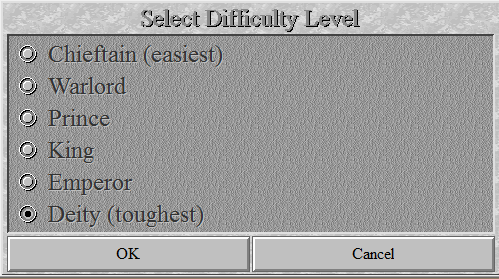
So here’s the big choice. A lot of stuff changes as the difficulty modes scale up. This is an incomplete list:
1) There are fewer turns before the end of the game. The time limit can actually be a crunch on Deity for newer players.
2) The AI is slightly smarter. They’ll do nasty tricks like using their Diplomats to steal your cities more often and more cleverly.
3) The AI cheats harder. They build stuff and get science advancements at a much faster rate. On Deity mode an AI with a Fundamentalist government and just a few tiny cities can get scientific advancements almost as rapidly as a human-controlled, continent-spanning Democracy of 50+ size 12+ metropoli.
4) Barbarian units have higher attack power (up to 50% more than normal units on Deity).
5) Your citizens are angrier. This is the big one. I can’t explain the details until I’ve had time to introduce more of the game mechanics, but by the time you get up to Deity level the game is unplayable unless you have a complete understanding of the happiness mechanics. Your cities will basically be in permanent Civil Disorder (which means they do absolutely nothing and can even cause your government to collapse) unless you fight tooth and nail and micromanage them all to keep them content. If you can get your civilization off the ground, this becomes a bit less of a problem later in the game since there are more ways to make people happy without destroying production entirely. Still, just maintaining order will be a constant battle.
As promised, I’ll be playing on Deity. That’ll be a big nuisance. If you’re more interested in fun than sheer challenge, I recommend King or Emperor instead.
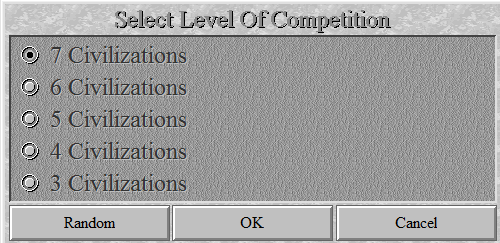
More civilizations means less space for each of us and more border wars faster. Bring it on!
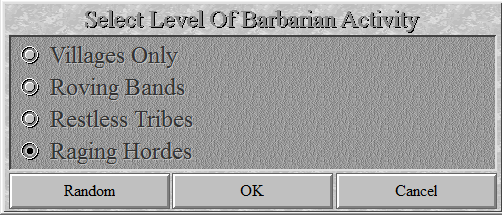
Barbarians poof out of thin air on random turns and in random places, posing a constant threat to a young civilization. This is especially true on Deity difficulty where you have no resources to spare and they have secretly boosted attack power.
Raging Hordes mostly means there are more of them and they appear earlier.
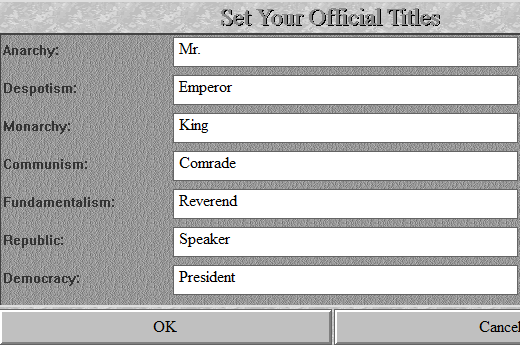
Time to choose the cosmetic titles I’ll have in each possible type of government. I’ve decided to play as the Romans, which is also an almost purely cosmetic choice. The only difference it makes is that no enemy can play as the Romans (or the Russians or Celts) and the enemy AI supposedly changes slightly depending on what civilization they’re playing as. Honestly, I’ve never noticed a significant difference in AI behavior.
Notice the complete list of governments by the way. I’ll talk about the details of them later, but for now you’ll want to know that that list is basically in ascending order of quality (without considering accessibility).
Anarchy is completely non-functional and is just an interim government you get when you screw up horribly or decide to transition to a new government.
Despotism is what you start in. It sucks at absolutely everything and you want to get out of it fast and never return.
Monarchy is an improvement over Despotism which is actually functional. It’s sort of the generic, average government and is available very early on. However, getting it does require a slight detour away from rushing right to Republic, which is the main (generally better) alternative.
Communism is an improved Monarchy and the last of the “normal” governments. It’s the worst government in the game and you should never, ever use it under any circumstances. This is because it’s higher-tech than both Democracy and Fundamentalism but not as good as either at their specialties. Also the technology that unlocks it actually cripples you with a terrible unhappiness penalty.
Fundamentalism is a late-game niche government. It’s matchlessly good at fighting short-term wars, but sucks at everything else and thus will cripple you if you can’t win quickly.
Republic is the early game good government. It’s better for most purposes than Monarchy but requires some skill to use properly and can’t be unlocked as soon. Getting here quickly is priority one for most advanced strategies.
Democracy is a mid-late-game improvement over Republic but with a few major weaknesses that require very skillful play. In good hands it’s the one government to rule them all. Getting here quickly is priority three for most advanced strategies.

And that’s about it, time to get started!
Let’s Play!
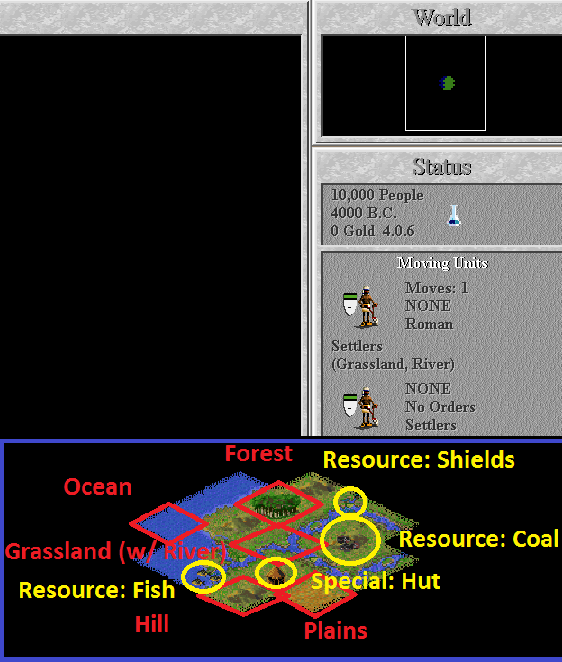
Besides a random starting position in a randomized world, you can also get random starting bonuses like free technology or an extra Settler. I didn’t get any extra technology at all, but I did get an extra Settler (this is actually guaranteed on Deity difficulty for some reason) and what looks like a good start position. Both Settlers are hidden in this shot to show the terrain better, but they're standing right in the middle of the revealed area.
In the top right corner you can see the mostly unexplored world map. The important thing to note is that it looks like I’m roughly in the middle north-south but probably a bit north of the equator. Thus I should expect to find hotter terrain types (Jungles, Deserts, etc.) if I go south and colder ones (like Tundra) if I go north. But I’m in a temperate zone, which is nice because both hot and cold terrain types suck.
Time to talk about the main map though. So one thing to immediately notice is that the map is made of diamonds of terrain rather than squares. This is what’s called an isometric grid. I'll call them tiles or squares interchangeably anyway.
Now I'd better explain what terrain means. Conveniently, quite a few different types of terrain are on display in this small area. But what differs between various types of terrain?
1) Movement costs. Ships can’t move on land and land units can’t move on Oceans. Other than that, almost every unit can move exactly 1 square per turn (vertical, horizontal, or diagonal) regardless of terrain type. However, some units like Horsemen or Tanks can move more than one square per turn. Forests, Hills, Mountains, etc. slow them down greatly (usually to just 1 square per turn).
2) Defensive bonuses. Units have their defense stat multiplied when standing on certain types of terrain. A 50% bonus is fairly common; Forests and Swamps and Jungles and such all grant that much. Hills give a game-changing 100% bonus. And Mountains, though rare, give a basically insurmountable 200% bonus.
3) Benefits from use. Your cities can work nearby terrain tiles of your selection (more on that later). What working a given tile grants you is determined by the terrain type. All terrain gives some combination of three things: Food, Production, and Trade.
4) Allowed improvements/transformations. Settler units (and Engineers later) can make improvements to some types of terrain. For example, Hills can be "Irrigated" to grant increased Food when worked or "Mined" to grant greatly increased Production. All land terrain can have Roads built on it to make it easier to move through (and increase Trade on some types of terrain). Finally, Settlers and especially Engineers can turn some types of terrain into others. For example, Plains can be Irrigated but cannot be Mined. However, Plains can be converted into Forests. Which of these options is possible and how long it takes is determined by the terrain type.
I won’t go into all the details just yet, but I’ll talk a bit about the Food, Production, and Trade granted by some of these terrain types and how that affects their usefulness. I'll use X/Y/Z to denote how much Food/Production/Trade a type of terrain gives.
You can see that my starting area is right near the coast. Ocean terrain is moderately useful early in the game and is basically the best thing in the universe by the end. It gives a respectable 1/0/2 when worked- that 2 Trade is particularly nice for your all-important technology growth early on. Another important factor is that only cities which are right next to Oceans can build ships or the buildings (Harbors and Offshore Platforms) which make Oceans wonderful later.
I don’t have many Forests around, but 1-2 is generally ideal anyway. Forests give 1/2/0, which isn't as good as it sounds. The trouble with them is that they can’t really be improved at all- only turned into Plains.
And Plains kind of suck. They give only 1/1/0. You can Irrigate them for +1 Food and Roads on them give +1 Trade, but they’re still mediocre at best.
The other bad type of land terrain nearby are Hills. Hills give 1/0/0. Terrible. However, when Mines are built on them, they grant 1/3/0 and thus completely outclass Forests. Forests are squashed between Plains granting better Food when Irrigated and Hills granting better Production when Mined. But in the early parts of the game where I can’t Irrigate or Mine or build Roads, Forests are handy for some easy production.
Now lastly you’ll notice some blue and green patches on land. Those are Grasslands with Rivers on them. Let me talk about Rivers first. Rivers are not a terrain type of their own, instead any kind of terrain can have a river on it (but Plains and Grasslands have by far the most). Rivers are great. They grants +1 Trade to whatever terrain they’re on. Additionally, units can move along them at triple speed. Oh and finally they grant an additional 50% defensive bonus to all units on them.
What about Grasslands? Well Grasslands are your bread and butter good terrain. They 2/0/0, the most food of any normal terrain, and can easily be Irrigated to give even more. Of course, lack of Production and Trade is unfortunate, but Food is really precious early in the game. Further, Roads make them give +1 Trade and they’re extremely likely to also have a special resource on them that grants +1 Production anyway.
So now I'd better talk about resources. In a way, resources are a lot like Rivers. Any terrain type can have them and they grant increased Food or Production or Trade when the terrain they’re on is worked. The difference is that they don’t grant increased movement or defensive bonuses and also that the types of resources that can appear depends on the terrain type.
Those little blobby triangle things on a lot of my Grasslands are a resource called “Shields”. I have no idea why except that in this game Production is measured in shields (also no idea why). Normally a Grassland gives 2 Food, 0 Production, and 0 Trade. With a Shield it also gives 1 Production for a total of 2/1/0. Shields are way more common but less dramatic than other resource types. You can see that about half of the Grasslands near me have them.
A more powerful resource is Fish, which Oceans can have. Fish make that Ocean tile give +2 Food for a total of 3/0/2 instead of 1/0/2. Oceans can also have Whales which are even better. A Whale would make the Ocean give 2/2/3!
Also nearby is Coal on one of my Hills. Coal makes the Hill give +2 production, which makes it just as good as a Forest to start with. The +3 from building a Mine later will stack, granting an absolutely amazing 5 shields worth of production overall.
So that covers nearly everything. The last thing nearby is the hut on one nearby square. Huts or villages or “goody bags” in the parlance of many Civ 2 players grant a one-time bonus to the first player to move a unit onto them and then disappear. They can appear on just about any terrain type. So what can happen?
1) Nothing.
2) A pile of barbarians pops out.
3) You get a very small or fairly small amount of gold.
4) You get a random technology that you have the prereqs for.
5) You get a random low-tech military unit.
6) You get a free settler unit.
7) You instantly get a city on the village’s spot.
If you’re catastrophically unlucky with a hut early on (barbarians spawn near your only city or something), it’s pretty much a game over. Still, you’d better go for it. The possible rewards are tremendous and although the probabilities change over the course of the game in complicated ways, the bad outcomes are never likely.
All in all, this looks like a very good immediate starting area and the fact that I have 2 Settlers instead of just 1 is nice too. Things could be better, but this is very good.

First things first, I visited the hut with one of my Settlers and I got a random military unit (an Archer). The reason I did this first is that if I built a city first and then found a military unit, the unit would be "supported" from that city (which costs production every turn). Since I got the unit before I had any cities, the unit is supported for free forever.
Now as for Archers in particular, they’re well-balanced and very strong for this phase of the game. The disadvantage of them is that the technology that normally unlocks them is pretty useless otherwise and that they cost more to build than more specialized units.
Mostly I’ll be using this one to explore.

So here are my forces. The new Archer moved south, revealing a bit more terrain. One of my first two Settlers is still in the starting tile and I’m going to have him found my first city there. Building a city is something only a Settler can do (and consumes the Settler). Cities are everything in this game though. They build your units, they produce your money and science, everything. You need to build as many as you can as fast as you can in this phase of the game.
Anyway, they can be named whatever one wants. I'll be taking suggestions for city names from readers during this LP. I'll also try to honor requests about what sorts of terrain the so-named city should be on and what sorts of stuff it should produce, but I can't make any promises in that regard.
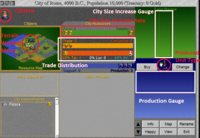
So, here’s the city menu, which is where I spend most of the game since micro-managing every city every turn is the key to surviving Deity difficulty. I won’t be showing most of that of course, but there are a few things worth explaining.
First of all, this is a city of size 1. All cities start at that size and then can grow over time. That number will be displayed on the map. Additionally, there will be a number of heads in the top left corner of this menu equal to the city size (which is the number of units of "citizens" the city is said to have). Right now there’s just 1 of course. What do those citizen symbols mean? Well the important thing is the color of the guy’s shirt. Blue means he’s "content". Red would mean "unhappy". Teal is rare and would mean "happy". Black is rare and would mean "angry".
If the number of unhappy citizens (angry citizens count as 2 unhappy citizens for all purposes) exceeds the number of happy ones, the city will go into "civil disorder" at the end of the turn and stay that way till you change something. Note that content citizens don't count for either side, so 1 unhappy citizen and a dozen content ones will result in civil disorder. In civil disorder the city gets no Trade or Production and you can’t do much of anything with it. Also, if you’re a Democracy, your whole government can collapse into Anarchy, which often causes mass famines and potentially makes you lose the whole game.
The reason Deity difficulty is so hard is that every citizen after the first one in each city is unhappy. This means your cities immediately go into civil disorder as soon as they hit size 2 unless you do something about that. The worst part is that after you have a few more cities, even the first citizen starts off unhappy so that your city goes into disorder immediately after being built. In that case there’s basically nothing whatsoever you can do with the city unless you have some other way to create happy citizens. More on that later.
Now also in the top left is the map of the city surrounds, showing the area that that city’s citizens can be tasked to work. It basically includes every tile within 2 moves, but note that it does NOT include the tiles 2 away horizontally or vertically.
Anyway, the tile the city is on is always worked without needing to use any citizens and is treated for all purposes as if it had the maximum possible improvements (in this case a Road and Irrigation, eventually also things like Railroads when unlocked). Additionally, if the tile would give 0 Production, it gives 1 Production anyway.
Math time! So I said that Grasslands give 2 Food, no Production, and no Trade. Having a River is +1 Trade and having a Road is another +1. Being a city square gives 1 Production for free. And Irrigation should be another +1 Food. So the city center Grassland should be 3/1/2. But counting wheat bundles, shields, and trade arrows on the little map, you’ll see there’s only 2/1/2. What’s going on?
Despotism! As it turns out, Melth the immortal God-Emperor of Romankind has a really cruddy government. Under Despotism, any terrain that should grant 3 or more of something grants 1 less. This Despotism penalty is catastrophic and one really needs to get out of Despotism fast to end it.
Anyway, besides the city tile being worked for free, you can also work a number of tiles of your choice equal to the number of citizens. You can see that in this case the Forest to the north is being worked, which gives 1 Food and 2 Production.
Now in the top middle are the details on Food, Trade, and Production. First note that although you can count a total of 3 wheat bundles on the minimap, I only have a surplus of 1 Food. A city consumes 2 Food for every citizen. Thus as your city grows to size 2, you must have the new citizen work a tile that gives at least 2 Food to continue the same growth rate. In the top right is a box that will fill up with the amount of Food surplus acquired each turn. The turn after the box is filled, the city increases in size.
Below the Food section is the Trade section. Trade is your economy and you can divide it among 3 things: Taxes, Luxuries, and Science. You can choose what % of your Trade goes to each in another menu (the %s are set the same for all cities). Under Despotism, you can’t set any category above 60%, so no 100% focus on Science or anything. As you can see, my %s are 60 to Science and 40 to Taxes and 0 to Luxuries.
Taxes are your gold income (and also pay for maintaining city improvements, more on them in the future). Science gives you your new technologies. Every 2 Luxuries turn an unhappy citizen content or a content one happy.
Now in the middle-right is another gauge box; every turn the city's Production shield surplus is put in there. When it fills, the chosen unit to create will appear in the city, ready to move.
There's more about cities to describe later, but that summary should do for now.
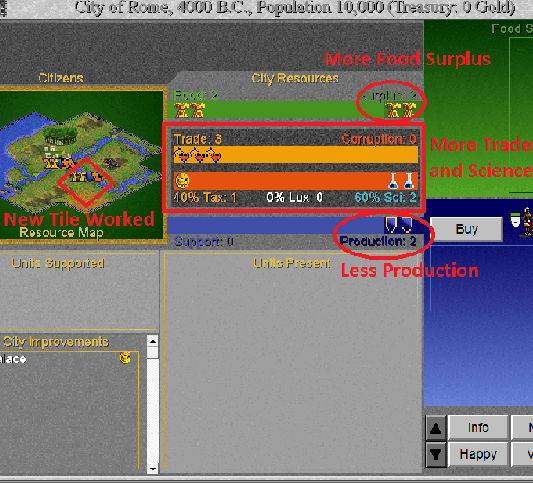
Alright, so in this shot I changed which tile is being worked from the Forest to the Grassland with the River to the southeast. This gives 1 more Food, 1 more Trade, and 1 less Production (as you can see in the middle). Importantly, this now gives me 2 Science instead of 1. I need all the science I can get at this stage.
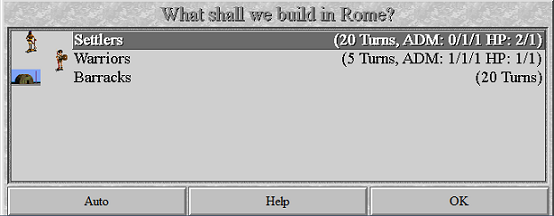
Now what do I make? Warriors are garbage. Barracks serve no purpose whatsoever at this stage of the game and would drain money every turn. What I need are more settlers to make more cities.
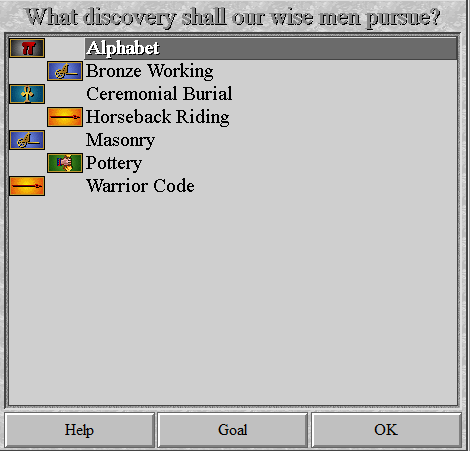
Now that I have my first city, the game prompts me to choose which science technology advancement I’ll get in a few turns. You cannot change this halfway through and it takes quite a few turns to get a new advance (depending on your total amount of Science in each city), so choose well.
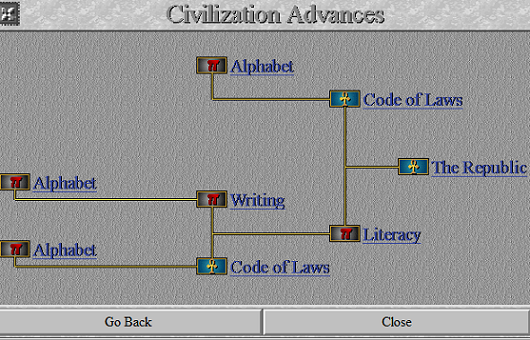
My goal is “The Republic”, which will let me change my government to a Republic. This techtree illustrates that for that I need to start with the Alphabet tech, which will unlock Code of Laws and Writing, which will unlock Literacy, which will unlock The Republic.
Alphabet doesn’t do much else, but Code of Laws lets me build Courthouses (worthless) and Writing lets me make Diplomats (amazing later) and Literacy would let me build the Great Library (a very good wonder of the world)
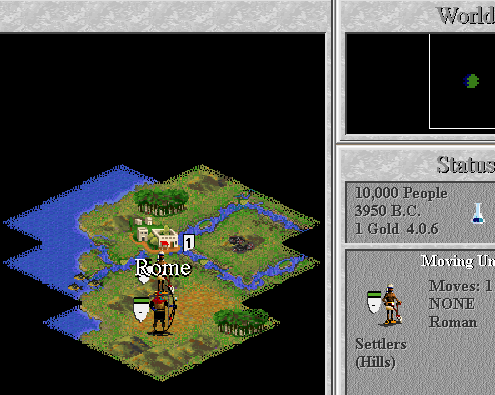
So now it’s next turn. In the toppish right you can see the year is now 3950 BC (50 later) and I have 1 Gold (because Rome produced that much Taxes).
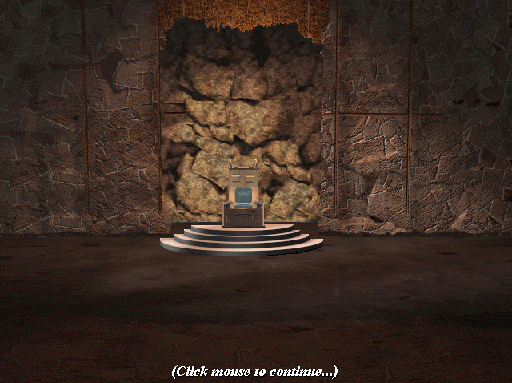
Cosmetically, the game periodically asks you to decorate a throne room for yourself. I’ll start with an actual throne and probably won’t bother to show this again for a while.
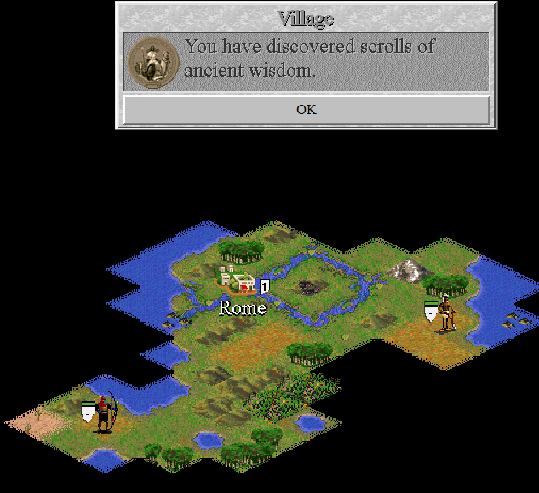
I spread out exploring for new good city sites and found another hut, which gave me a new technology.
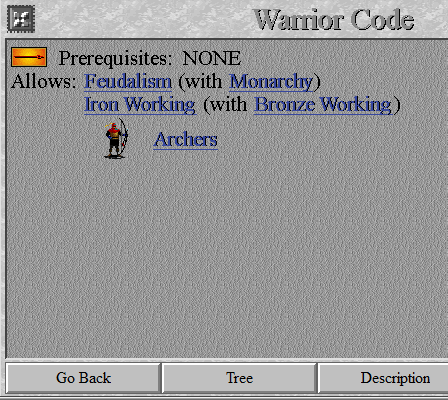
Alright, I got Warrior Code. This lets me build my own Archers if I want to but is otherwise mostly useless.
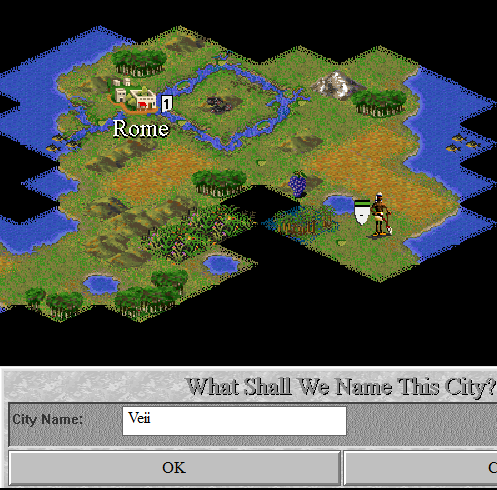
I spent a lot more turns than I wanted to, but I found a very good site I believe. One thing you’ll notice is that in both cases I chose to found my city on a Grassland that did NOT have a Shield resource on it. That’s a very key point of strategy. See, as I mentioned, a city tile which would normally grant 0 Production will give 1 for free. This potential benefit is lost if you build somewhere that already gives Production.
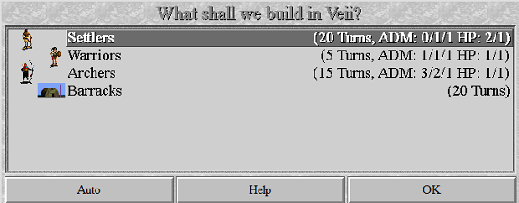
More settlers!
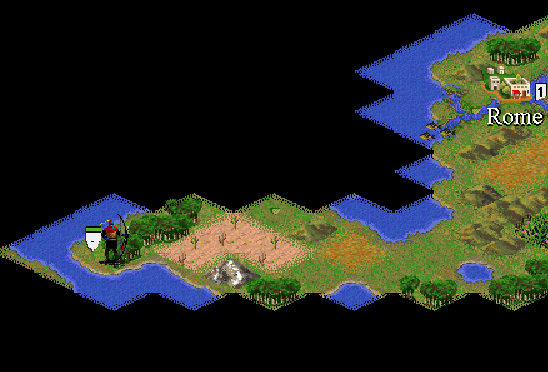
Well my archer has found the edge of the earth in that direction. Even late in the game, crossing Oceans is no small matter. Any area of my territory I have an Ocean next to is pretty much safe from everything but random barbarian spawns.
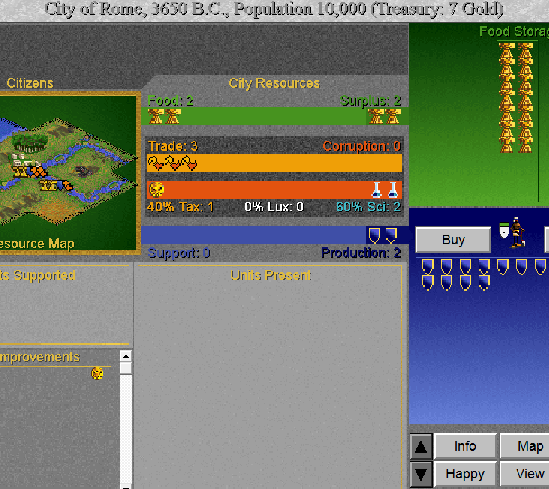
Revisiting Rome, I’ll switch the worked tile from the Grassland to the Forest again to slow down city growth and speed up Settler production. Having the city grow to size 2 doesn’t help me at all since it will then go into civil disorder unless I have the new citizen be an "Entertainer" instead of producing anything valuable (I’ll explain later). But when a city produces a Settler, the city shrinks by one size. If the city is not size 2 or higher, the whole city is disbanded! Thus I need my city to grow before I finish the Settler, but there’s no reason to have it finish more than a turn or two ahead of time.

Alright, my first learned technology. Now I must immediately choose a new one to research.
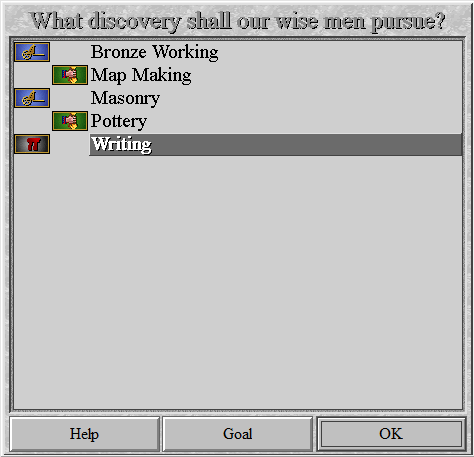
Now I need to learn both Code of Laws and Writing, and both are unlocked, but you’ll notice Code of Laws isn’t on this list. Why?
Well basically any given tech you SHOULD be able to research is made unavailable 1/3 of the time at random. This is stupid and terrible and serves no purpose but to add a luck-based slowdown to your attempts to reach key techs.
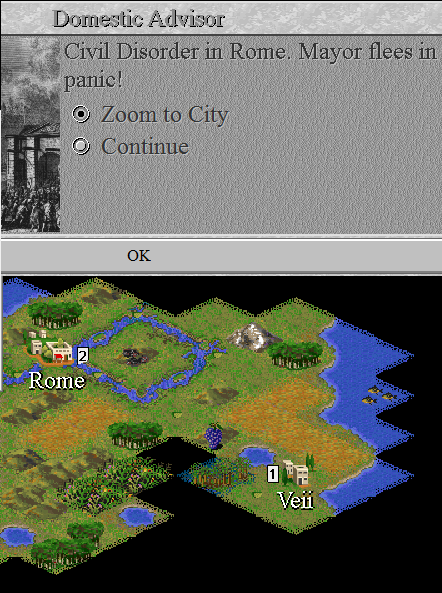
Rome grew to size 2, so instant civil disorder because this is Deity difficulty.
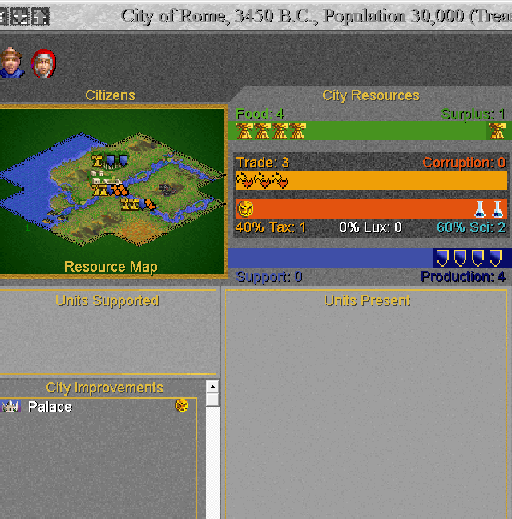
Notice that in the top left there are now 2 people, but one is in red. Thus there’s 1 unhappy citizen and 0 happy citizens (content ones don’t count) and therefore civil disorder will occur at the end of this turn if I don’t fix things. And all the listed food and trade and production won’t actually happen.

So what I did was turn one citizen into an “Entertainer” instead of working a tile. That's the Elvis impersonator in the top left. Entertainers produce 2 Luxuries and thus make one unhappy person content. Thus no disorder.
You can also turn citizens into "Tax Collectors" or "Scientists", which produce extra Gold or Science instead of Luxuries. Rarely worth doing. Anyway, you can freely change who works what tile or is an Entertainer or Scientist or whatever every turn.
Let me bring your attention to a major nuisance here though. See, you’ll note I now have Food surplus 0 because a size 2 city consumes 4 Food and I can only bring in 4 max. If I changed the tile worked from the Grassland to the Forest, my surplus would go to negative one. Then when that top right box emptied in a turn, the city would SHRINK as famine ensued. This would ruin everything because I would need to fill it all the way back up to get back to size 2 so that I could actually produce my darned Settlers without disbanding the city. Thus I can’t work the Forest, so I can’t produce the Settler faster.
None of this is a problem even on Emperor difficulty; you can get to size 2 without civil disorder, so everything is easy and not a horrible nuisance to deal with every single turn.
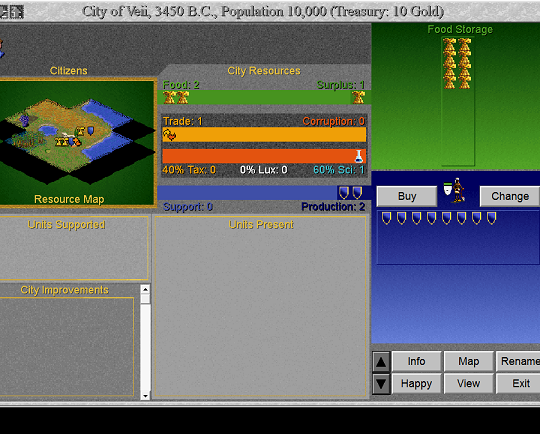
I try to micro the other city as best I can, but there isn’t that much different terrain to choose from here. One thing you can see is that I’m choosing to work a Plain instead of a Grassland with a Shield on some turns in order to slow down overall Food gain and thus make sure the city doesn’t grow too early. Again, you don’t have to deliberately shoot yourself in the foot just to prevent your cities from rioting and ruining everything on Emperor or below.
Oh and note that since I haven’t explored all around that city, some tiles in its local map are black and unusable.
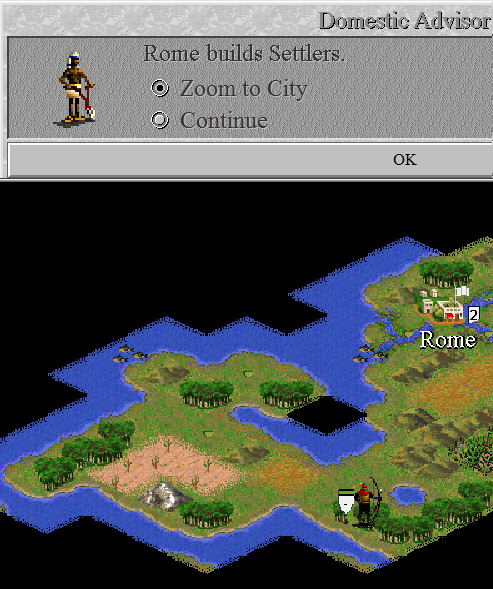
A few turns later, Rome finishes my new Settlers. That 2 on the map will soon turn to a 1 as the city consequently shrinks.

The Settlers go out looking for another site and my Archer keeps exploring. The Settlers found a hut that gave me a Horsemen unit.
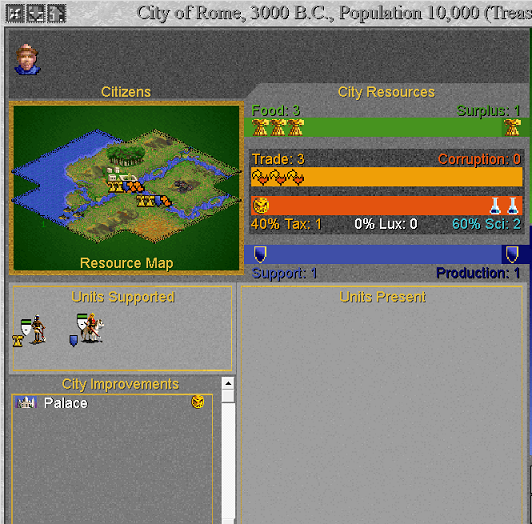
So, looking at Rome now, it’s time to talk about unit support. Every unit has a cost in Production or Food that must be paid every turn to support it. Generally speaking, this is a single unit of Production and it must be paid by the city that built it. You can change which city must pay support each turn by walking the unit to the new city you want to support from and choosing an option to change support there. Obviously, this takes considerable time and the original city must pay until you get there.
You’ll also note that there just isn’t that much Production available to begin with, so every 1 per turn you must pay is a huge decrease remaining surplus with which to build new stuff. Furthermore, if your city’s Production surplus ever goes negative (for example, you need to switch away from high Production terrain to high Food terrain while you have a lot of units supported), your supported units in the field can be disbanded without asking you. This can happen quite a lot during a war because a war can prevent you from using certain terrain tiles. More on that later.
Settlers are even worse. They cost precious Food as well as Production- and their cost per turn actually rises further in more advanced governments. In a Republic or Democracy, every single unit of Settlers costs a huge 2 Food and 1 Production per turn. This is arguably the single greatest disadvantage of those forms of government.
Fortunately, not every single unit has a support cost. First of all, units gained before you have any cities or acquired from huts very far from your existing cities have no cost ever. Also, a few units spawned during unusual circumstances (like the free Partisans you sometimes get if you lose a city after learning the Guerilla Warfare tech) have no cost. Most importantly, your cities will cover Production support costs for a few units for free depending on your government. In a Monarchy, every city will support 3 units for free. In a Despotism every city will support its size worth of units for free. Republics and Democracy never get any free support, but they can make up for that in other ways.
As you can see on the left, Rome is size 1 and thus doesn't have to pay shields to support its Settler but does have to pay everything else. Just another incentive to get good use out of the Horseman or get rid of it and have that Settler turn into a new city fast.
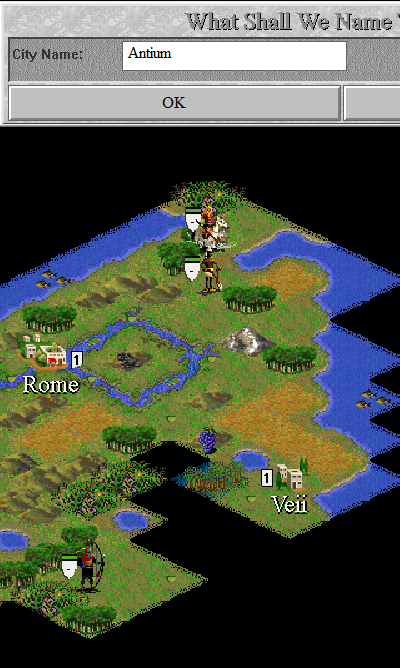
Right now for example. This is a pretty good spot.
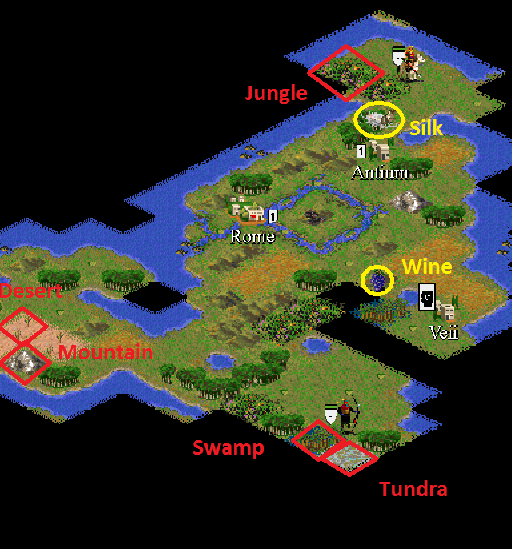
Whee! Veii grows to size 2 and thus instantly has civil disorder.
A few more types of terrain are on display here, but very few new resources. I have had bad luck with resources all in all. Not even many Rivers away from Rome. One good thing about the terrain so far is that my territory looks like it has very few ways in and out. That doesn’t help at all vs barbarians (who I have no possible way to defend myself from yet) but is good for when I meet other civilizations.
Anyway, Deserts and Mountains grant a terrible 0/1/0, Tundra and Swamps and Jungles grant a terrible 1/0/0 but Settlers can slowly convert the latter two into Grasslands.The only terrain I haven’t seen yet are Glaciers, which quite literally produce nothing. Once in a while one randomly starts in a pure-Glacier arctic continent and therefore must restart on turn 1 since any city built will disband immediately.
Anyway, two new resources are seen here: Silk and Wine. Silk adds 3 Trade to its square and Wine adds 4, once again making mined Hills strictly better than Forests. Both are quite respectable resources though.
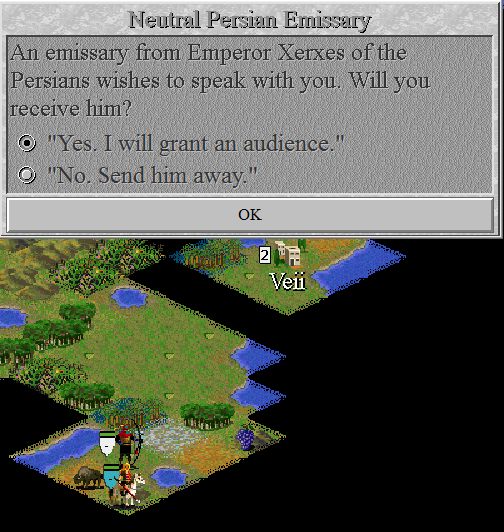
Ah ha! First contact. That teal Horseman in the bottom moved up and found my Archer, so now I can do diplomacy with the Persians it seems. You should ALWAYS do diplomacy whenever it’s offered. Even if you intend to win via world conquest, diplomacy can be exploited for piles of gold and technology if you play your cards right. In fact, you should often phone up the other world leaders and initiate diplomacy with them.
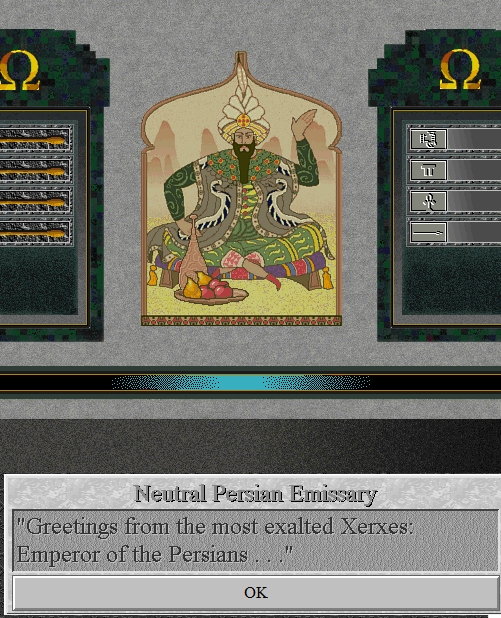
So here’s the beginning of the diplomacy screen. Just a few things to note here. Number one, the emissary is described as “Neutral”. That’s his country’s attitude to you. What you do in diplomacy as well as your relative power and so forth will change this up and down.

Generally speaking, newly found civs propose peace immediately. Now they might break this later, but probably only if they hate you. What’s critical is that not only can you not attack someone you have a treaty with without breaking it, you can’t walk past them AT ALL. You can’t even break the treaty to walk past. So if you sign a peace treaty, a smart player can block the enemy out of their own territory more or less forever, which is great for settling it safely.
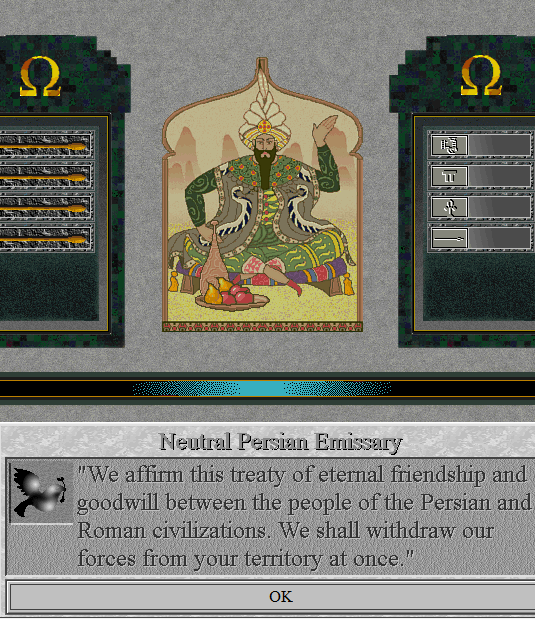
And withdrawing forces is the other thing. You can’t move your units within range of their cities and they can’t do the same to you. If you try to do that, you’ll either have to move through immediately, break the treaty, or have your unit teleported home to the nearest city- a major nuisance.
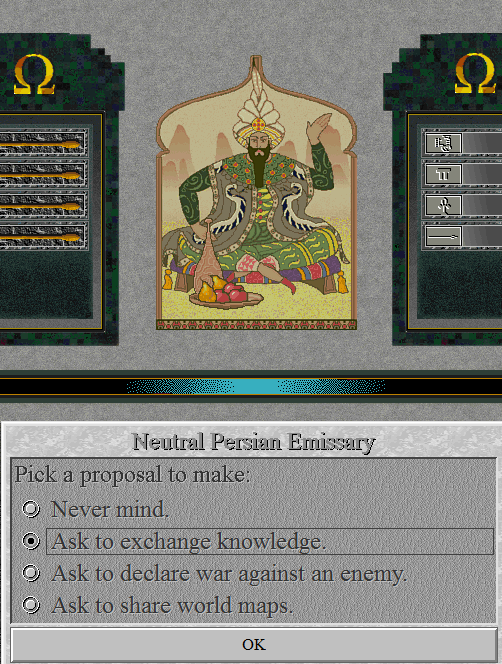
So now we can get into the real diplomacy. Sharing world maps is great, but the AI civs basically won't do it unless their attitude is "Worshipful" (the max). Asking to declare war against an enemy is mostly worthless since the AI typically won’t neighbor your other enemy and thus will contribute nothing.
But exchange knowledge is amazing. You can trade technologies, which is the fastest way to get new ones. The best part is that (unlike most of these other options) the other civilization actually LIKES it and will become friendlier to you. It's typically the best way to make people friendly.
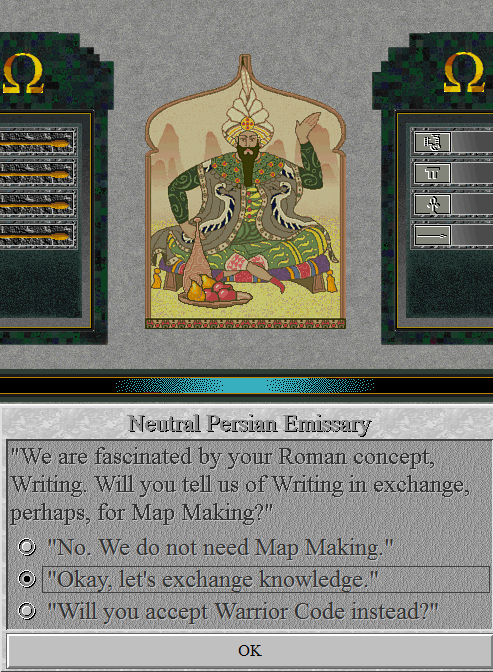
I don’t care what they ask for and I don’t care what they’re offering, accept the offer. Trying to offer them something else instead will often result in the deal getting rejected and them ending the diplomacy. Plus it’s not like the AI will actually benefit a ton from most techs.

The other thing is that you don’t actually have to take the tech they offered, you can take a different one they know after accepting the deal. Ceremonial Burial lets me build Temples, which are basically the first good way to keep your citizens content. It would also be the last prereq I needed to research Monarchy. And it’s the start of the religion chain, which is critically important.
Horseback Riding lets me build Horsemen, which are decent units in their own right. Also, for some reason, it’s needed for part of the religion chain, so I need it. People in areas with no horses had no religions, everyone knows that!
Mapmaking is also a good tech because it unlocks Triremes, the first naval unit.

So I took Ceremonial Burial and they wanted to trade again, still offering Map Making. Of course I accepted. Offer them whatever they want, but take whatever you want instead of what they offered.
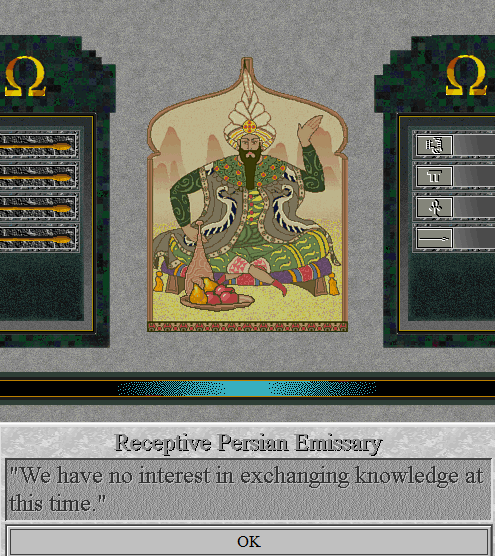
This means I only knew 2 techs they didn't have, so I couldn't trade for their third. Oh well. Also note that their friendliness has gone up from "neutral" to “receptive”. Above that are cordial then enthusiastic and then worshipful.
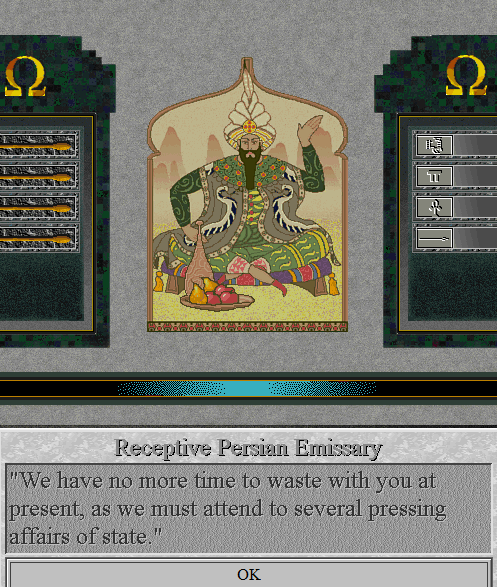
And they rudely end the diplomacy immediately. Darn. There’s no way to be sure when they’ll do that. If they hadn’t, I was going to ask them for money and they might have actually given me some.
Anyway, that concludes first contact, so it’s a good place to end episode 1 of this LP.